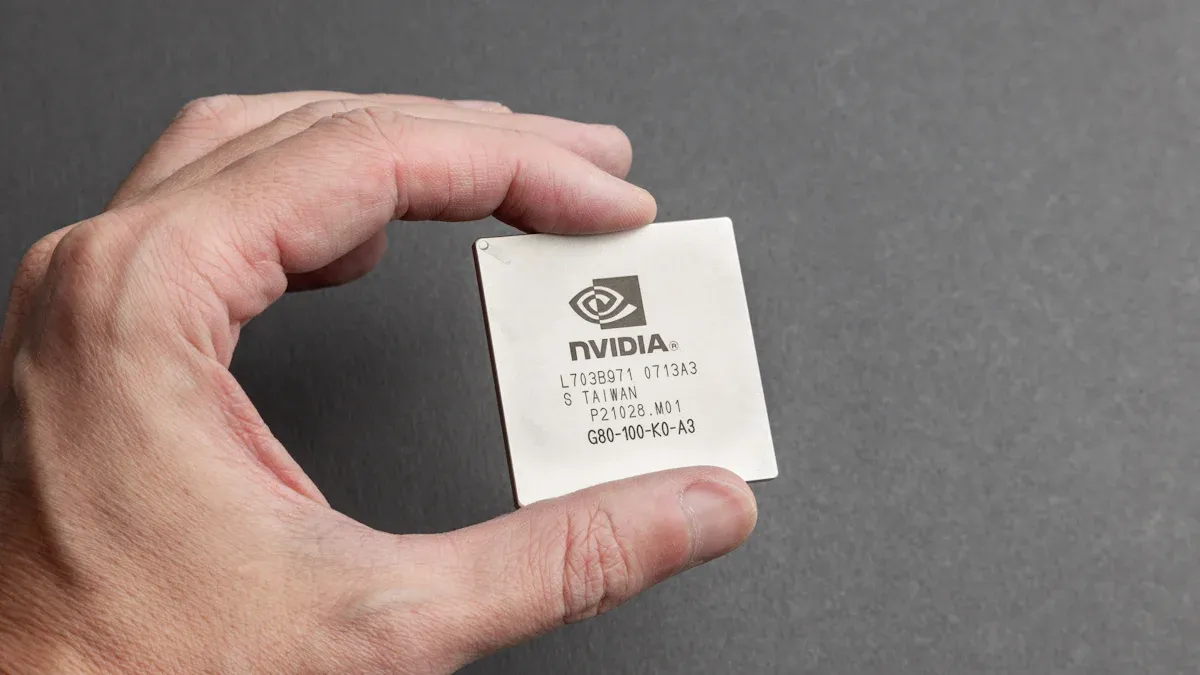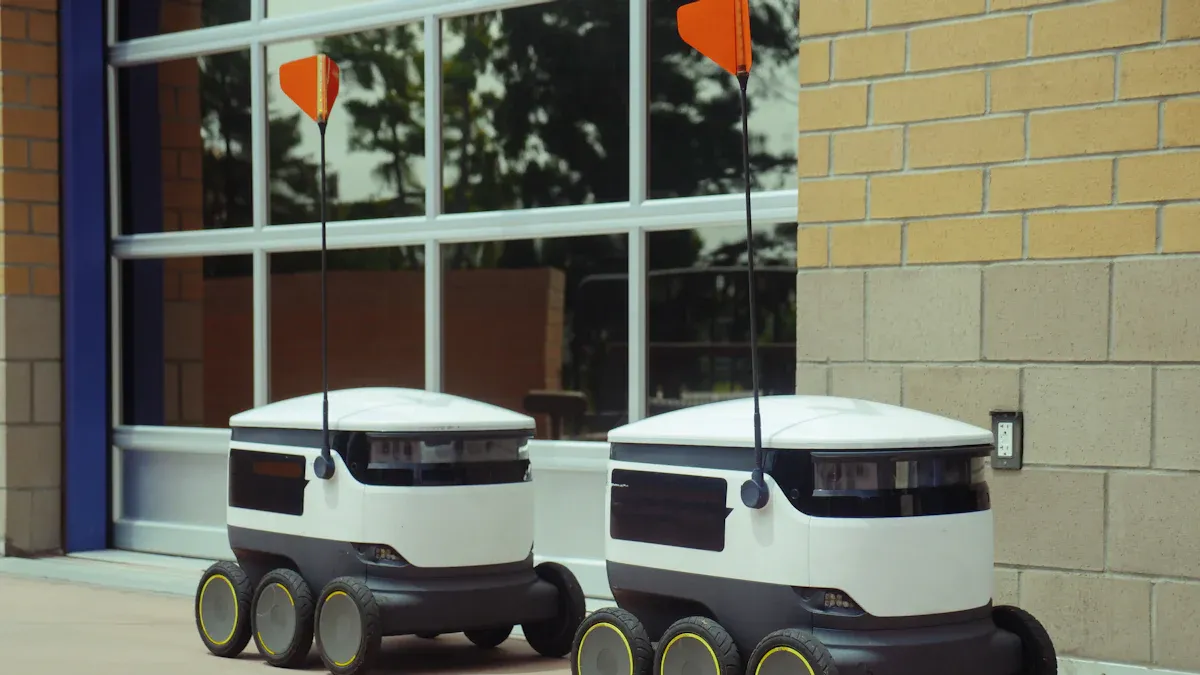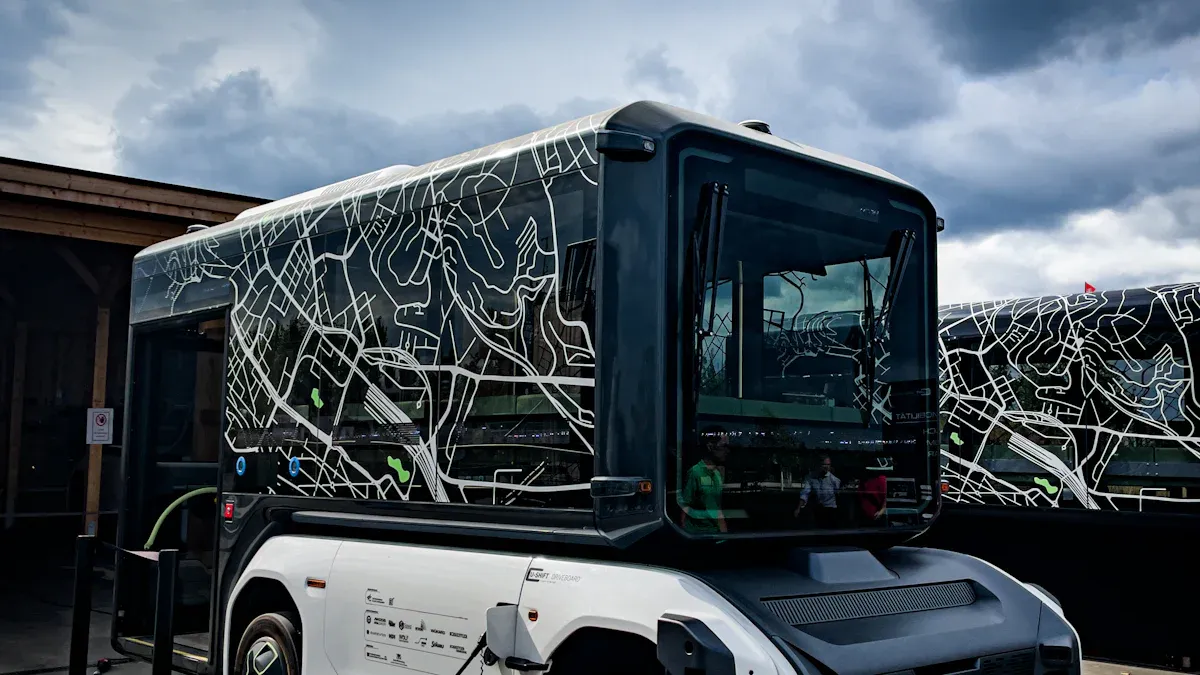Revolutionizing Autonomous Vehicles with NVIDIA Solutions

NVIDIA stands at the forefront of autonomous vehicle innovation, redefining the automotive landscape with cutting-edge technology. Its DRIVE AGX Orin platform delivers unparalleled computational power, enabling intelligent fleets and smarter mobility solutions. Collaborations with industry leaders like General Motors and Volvo Cars showcase NVIDIA's commitment to enhancing safety, efficiency, and accessibility. The company’s automotive revenue surged by 60% in fiscal 2023, reaching $903 million, highlighting its transformative impact on the sector. By addressing challenges such as driver shortages and operational costs, NVIDIA's AI-powered platforms are paving the way for a safer and more efficient future for autonomous vehicles on NVIDIA DRIVE.
Key Takeaways
NVIDIA's DRIVE AGX platform gives strong AI power for smarter cars.
The DRIVE Thor chip combines many car tasks, making them simpler.
NVIDIA Omniverse helps test cars in lifelike virtual worlds.
NVIDIA's AI helps trucks drive on their own, saving money and fuel.
NVIDIA focuses on safety, spending a lot on research and following rules.
NVIDIA's Core Technologies for Autonomous Vehicles

NVIDIA DRIVE AGX: Scalable AI for Smarter Vehicles
NVIDIA DRIVE AGX serves as the backbone of intelligent vehicle operations, offering a scalable platform that supports everything from Level 2+ driver assistance to fully autonomous driving. This platform delivers up to 2,000 TOPS (trillions of operations per second) of AI performance, enabling real-time processing of complex data from cameras, radar, and lidar sensors. Its architecture ensures superior safety with ASIL-D compliance and redundancy, making it a reliable choice for automotive manufacturers.
The platform's scalability allows automakers to adapt it to various vehicle models and functionalities. For instance, Volvo integrated NVIDIA DRIVE Orin into its vehicle architecture in 2020. This collaboration aimed to enhance in-car experiences with AI and develop a future-proof platform for autonomous driving. By enabling over-the-air software updates and real-time sensor data processing, Volvo achieved improved safety features and a more seamless user experience.
Metric | Description |
|---|---|
AI Performance | Delivers up to 2,000 TOPS of AI performance. |
Scalability | Offers a scalable architecture supporting Level 2+ to fully autonomous driving. |
Safety Compliance | Provides superior safety, with ASIL-D compliance and redundancy. |
Real-time Performance | Supports a hypervisor for workload isolation and QNX for real-time performance. |
Energy Efficiency | Optimized for in-vehicle deployment with a power-efficient architecture. |
NVIDIA DRIVE AGX empowers automakers to create smarter, safer vehicles while addressing the growing demand for advanced driver assistance systems and autonomous capabilities.
DRIVE Thor: Unified Computing for Automotive Innovation
DRIVE Thor represents a leap forward in unified computing for the automotive industry. This system-on-a-chip (SoC) consolidates multiple functions, such as infotainment, driver assistance, and autonomous driving, into a single platform. By reducing the number of cables and hardware components, DRIVE Thor significantly lowers manufacturing costs and vehicle weight.
Engineered for generative AI applications, DRIVE Thor boasts 1,000 teraflops of performance, ensuring safety and security in autonomous machines. It also accelerates the inference performance of transformer deep neural networks by up to nine times, making it ideal for advanced AI workloads. With 2,000 teraflops of FP8 precision, the platform ensures accurate transitions from 32-bit to 8-bit formats, enhancing computational efficiency.
DRIVE Thor utilizes NVLink-C2C chip interconnect technology to distribute workloads efficiently across its architecture. This innovation allows automakers to streamline their development processes and deliver cutting-edge features to consumers. By unifying diverse automotive functions, DRIVE Thor sets a new standard for efficiency and performance in the industry.
Omniverse: Revolutionizing Vehicle Simulation and Collaboration
NVIDIA Omniverse transforms the way automakers design, test, and validate autonomous vehicles. This platform enables high-fidelity sensor simulations for cameras, radar, and lidar, which are essential for testing perception systems. It can simulate billions of driving scenarios, including rare and hazardous edge cases, to train robust AI models.
Omniverse's digital twin technology allows developers to create realistic virtual environments for comprehensive testing of autonomous vehicle software. This approach reduces the need for physical prototypes and accelerates the validation process. Additionally, the platform generates synthetic data to address challenges like insufficient data diversity and privacy concerns in AI model training.
The integration of Omniverse with tools like ANSYS enhances simulation workflows by providing advanced data processing and visualization capabilities. This collaboration minimizes reliance on simulation experts, making insights more accessible to decision-makers. By revolutionizing vehicle simulation and collaboration, Omniverse empowers automakers to innovate faster and more efficiently.
Real-World Applications of NVIDIA's Automotive Solutions
Passenger Vehicles: Redefining Driver Assistance and Autonomy
NVIDIA's innovations have transformed passenger vehicles by enhancing driver assistance systems (ADAS) and enabling higher levels of autonomy. The NVIDIA DRIVE platform integrates hardware and software to deliver advanced capabilities, such as real-time sensor data processing and AI-powered decision-making. These features improve safety, efficiency, and the overall driving experience.
The NVIDIA Thor system-on-chip (SoC) plays a pivotal role in advancing autonomous driving. By unifying multiple functions, such as infotainment and ADAS, into a single chip, Thor ensures seamless operation and reduces hardware complexity. Its ability to process sensor data in real time enhances safety by enabling vehicles to respond quickly to dynamic road conditions. Additionally, NVIDIA's DRIVE AI Systems Inspection Lab helps automakers meet stringent safety standards, ensuring compliance with functional safety and cybersecurity requirements.
Innovation | Description | Impact on Safety and Autonomy |
|---|---|---|
NVIDIA Thor SoC | A unified system-on-chip integrating various functions into one platform. | Enhances real-time sensor data processing, improving safety. |
DRIVE AI Systems Lab | Accredited lab for safety and cybersecurity compliance. | Ensures vehicles meet functional safety and AI integration needs. |
Collaborations with automakers like Mercedes-Benz further highlight NVIDIA's impact. By leveraging NVIDIA's comprehensive ecosystem, these partnerships have accelerated the development of autonomous vehicle technologies, bringing safer and smarter vehicles to market.
Autonomous Trucking: Transforming Freight with AI
NVIDIA's AI solutions are revolutionizing the freight industry by enabling autonomous trucking. These innovations address critical challenges, such as driver shortages and high operational costs, while improving delivery efficiency. Autonomous trucks equipped with NVIDIA DRIVE technology can operate continuously, reducing the need for human intervention and maximizing productivity.
Pilot programs with companies like TuSimple and the U.S. Postal Service have demonstrated the efficiency of NVIDIA's AI-powered systems. Autonomous trucks completed deliveries ahead of schedule, showcasing their ability to optimize routes and reduce transit times. Fuel consumption also decreased significantly, with estimates suggesting a 13%-32% reduction per loaded mile. These advancements not only lower costs but also contribute to environmental sustainability.
Key performance highlights of NVIDIA's autonomous trucking solutions:
Improved delivery times, with pilot runs arriving ahead of schedule.
Fuel savings of up to 32% per loaded mile.
Continuous operation, reducing reliance on human drivers.
Potential for 50% of U.S. freight miles to be driven autonomously by 2035.
Annual cost savings of over $6.8 billion for the logistics industry.
By integrating AI into freight operations, NVIDIA is paving the way for a more efficient and sustainable logistics network.
Teledriving: Remote Operations for Specialized Applications
Teledriving, powered by NVIDIA's remote operations technology, offers a unique solution for specialized applications. This approach allows trained operators to control vehicles remotely, providing flexibility and safety in complex scenarios. Companies like Vay have successfully implemented NVIDIA's technology to deliver innovative teledriving services.
Vay's remote driving service in Berlin, Germany, uses NVIDIA DRIVE AGX and DriveOS to enable real-time video streaming and human supervision. This setup ensures safe and efficient vehicle operation, even in challenging environments. The service has expanded to commercial operations in Las Vegas, with plans for further growth across Europe. Recent investments, such as a $34 million funding round from the European Investment Bank, highlight the potential of teledriving to reshape urban mobility.
Aspect | Details |
|---|---|
Company | Vay |
Location | Berlin, Germany |
Technology Used | NVIDIA DRIVE AGX, NVIDIA DriveOS |
Service Description | Remote driving service where trained teledrivers operate vehicles remotely to pick up customers. |
Unique Features | Real-time video streaming, human supervision, and ability to handle complex driving scenarios. |
Operational Area | Commercial services in Las Vegas, with plans for expansion across Europe. |
Recent Developments | Secured $34 million investment from the European Investment Bank for technology rollout. |
Teledriving represents a significant step forward in autonomous vehicle development. By combining human expertise with NVIDIA's advanced AI and computing platforms, this technology offers a practical solution for urban mobility and specialized use cases.
AI, Data, and Simulation in Autonomous Vehicle Development

Omniverse for Advanced Simulation and Testing
NVIDIA Omniverse plays a critical role in advancing autonomous vehicle development through its robust simulation capabilities. This platform enables automakers to test and validate autonomous systems in virtual environments, reducing reliance on physical prototypes. By simulating billions of driving scenarios, including rare and hazardous situations, Omniverse ensures comprehensive testing that would be impractical in real-world conditions.
Key metrics highlight the platform's effectiveness:
Efficient AI Validation: Omniverse evaluates the entire system, from sensor input to control output, identifying potential gaps.
Realistic Scenarios at Scale: It generates diverse training and testing scenarios, including edge cases that enhance system robustness.
High-Fidelity Sensor Simulation: NVIDIA Omniverse Sensor RTX APIs create realistic sensor data, improving the accuracy of AI models.
This approach accelerates development timelines and enhances safety, making it indispensable for autonomous vehicle innovation.
AI Frameworks for Training Autonomous Driving Models
AI frameworks form the backbone of training models for autonomous vehicles. These frameworks optimize energy usage, reduce delays, and improve path planning for smoother journeys. NVIDIA's advanced AI solutions minimize human error and enhance traffic flow through predictive analytics. They also improve road safety by analyzing vast datasets to anticipate potential hazards.
Key performance indicators include:
Optimized driving patterns for better traffic management.
Enhanced energy efficiency through advanced path planning.
Reduced computational delays, ensuring real-time decision-making.
However, training deep neural networks demands significant computational power. NVIDIA's GPUs provide the necessary resources, enabling researchers to develop and refine AI models effectively. These frameworks ensure autonomous vehicles operate reliably in complex environments.
NIM: Managing Data at Scale for Smarter Vehicles
NVIDIA's NIM (NVIDIA Infrastructure Manager) system addresses the challenges of managing massive datasets in autonomous vehicle development. Its microservices architecture allows flexible and efficient management of AI workflows. This design enables developers to scale individual components independently, ensuring seamless integration with evolving technologies.
Aspect | Description |
|---|---|
Microservices Architecture | Enables efficient scaling and development of AI components. |
Integration with LangChain | Adapts quickly to increasing data volumes and computational demands. |
Future-proof Solution | Provides infrastructure that grows with organizational needs, ensuring long-term viability. |
By leveraging NIM, automakers can process and analyze data at unprecedented scales. This capability supports smarter decision-making and accelerates the deployment of autonomous vehicles.
Safety and Scalability in Autonomous Vehicle Development
NVIDIA's Safety-First Approach to Autonomous Systems
NVIDIA prioritizes safety in autonomous vehicle development by adhering to rigorous standards and investing heavily in research. The company has dedicated over 15,000 engineering years to vehicle safety and contributed more than 10,000 hours to international standards committees. These efforts have resulted in over 1,000 patents and 240 research papers focused on AV safety. NVIDIA's DriveOS 6.0 complies with ISO 26262 ASIL D standards, ensuring the highest level of automotive safety integrity. Additionally, TÜV SÜD has certified NVIDIA's automotive platforms for cybersecurity, while TÜV Rheinland has independently assessed NVIDIA DRIVE AV for compliance with United Nations safety requirements.
Metric Description | Value |
|---|---|
Engineering years invested in vehicle safety | 15,000+ |
Contributions to international standards | 10,000+ hours |
AV-safety patents filed | 1,000+ |
AV-safety research papers published | 240+ |
Safety and cybersecurity certificates | 30+ |
These achievements underscore NVIDIA's commitment to creating safe and reliable autonomous systems, setting a benchmark for the automotive industry.
Developer Tools for Reliable and Scalable Solutions
NVIDIA provides developers with robust tools to build scalable and dependable autonomous vehicle solutions. Its GPUs, such as the H100 PCIe and A100 SXM, support up to 50 users and deliver high throughput, enabling rapid iteration and testing. These tools enhance productivity by facilitating the development of complex coding environments and ensuring accurate, contextually appropriate code responses.
GPU Model | Users Supported | Throughput (tokens/second) |
|---|---|---|
H100 PCIe | Up to 50 | 40 |
A100 SXM | Up to 50 | 40 |
H100 SXM | Up to 40 | 40 |
L40s PCIe | 5-10 | N/A |
L4 PCIe | N/A | N/A |
By leveraging these tools, developers can create reliable AV systems that meet the demands of real-time decision-making and complex operational scenarios.
Expanding Autonomous Capabilities Across Industries
NVIDIA's impact extends beyond the automotive industry, influencing sectors like healthcare and scientific research. Collaborations with automakers such as General Motors, Toyota, and Hyundai have accelerated the adoption of autonomous driving technologies. In healthcare, NVIDIA's AI-powered solutions have improved diagnostic accuracy and efficiency. Research institutions also use NVIDIA's AI expertise for advancements in genomics and climate science.
NVIDIA's DRIVE platform remains a preferred choice for automakers due to its superior performance metrics. These partnerships highlight the company's ability to drive innovation across multiple industries, reinforcing its leadership in AI and autonomous technologies.
NVIDIA continues to lead the automotive industry into a new era of innovation with its AI-defined autonomous vehicles and advanced driver-assistance systems. By integrating AI technology into its platforms, NVIDIA is enabling automakers to design smarter vehicles that leverage sensors for real-time decision-making and autonomous operations. Industry forecasts reveal that AI-related innovations could generate $215 billion in value for automotive OEMs by 2025, underscoring NVIDIA's pivotal role in shaping the future of mobility.
Collaborations with automakers like Volvo Cars and Uber Freight demonstrate the transformative impact of NVIDIA's AI-based stack. These partnerships enhance safety, operational efficiency, and consumer experiences. The introduction of Omniverse Blueprint for simulation and Cosmos world foundation models further accelerates the development of autonomous vehicles. As investments in AI technologies triple by 2027, NVIDIA's solutions will continue to redefine the automotive landscape, paving the way for safer, more intelligent mobility solutions.
🚗 Looking Ahead: NVIDIA's advancements in AI technology and autonomous operations promise a future where vehicles are not just modes of transport but intelligent systems that revolutionize mobility.
What makes NVIDIA's GPUs essential for autonomous vehicles?
NVIDIA's GPUs provide the computational power needed for real-time data processing and AI model training. They enable vehicles to analyze sensor inputs, make decisions, and operate autonomously with precision.
How does NVIDIA's software enhance vehicle safety?
NVIDIA's software integrates advanced algorithms to process sensor data and predict potential hazards. It ensures vehicles respond effectively to dynamic road conditions, improving passenger safety.
Can NVIDIA's advanced automotive solutions scale across industries?
Yes, NVIDIA's platforms support scalability, enabling their use in industries like healthcare and logistics. Their flexibility allows adaptation to diverse applications beyond automotive.
How does NVIDIA Omniverse improve autonomous vehicle testing?
Omniverse simulates billions of driving scenarios, including rare edge cases. It reduces reliance on physical prototypes, accelerates development, and ensures robust AI model validation.
What role does NVIDIA's software play in reducing operational costs?
NVIDIA's software optimizes vehicle operations by improving energy efficiency and route planning. These enhancements lower fuel consumption and maintenance costs for fleets.
See Also
Enhancing Robotics With RV1126's AI Edge Computing
Elevating Automotive Performance Using NXP Microcontrollers
Unveiling Essential Automotive Features of FREESCALE MCF5251CVM140
CALL US DIRECTLY
(+86)755-82724686
RM2508,BlockA,JiaheHuaqiangBuilding,ShenNanMiddleRd,Futian District,Shenzhen,518031,CN
www.keepboomingtech.com sales@keepboomingtech.com
